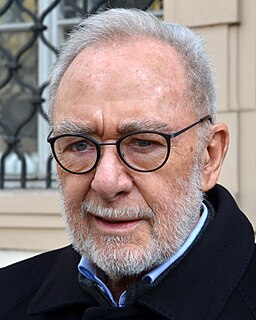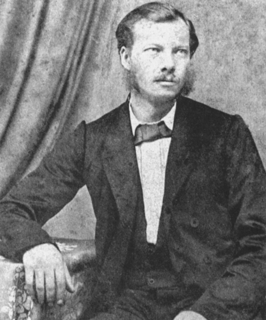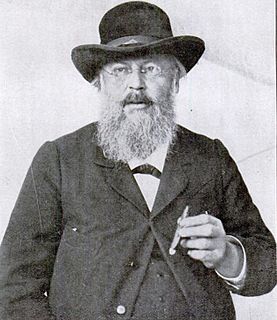
Gerhard Richter is a German visual artist. Richter has produced abstract as well as photorealistic paintings, and also photographs and glass pieces. He is widely regarded as one of the most important contemporary German artists and several of his works have set record prices at auction.

The Papiermark was the German currency from 4 August 1914 when the link between the Goldmark and gold was abandoned, due to the outbreak of World War I. In particular, the Papiermark was the currency issued during the hyperinflation in Germany of 1922 and 1923.

Johann Ludwig (Louis) Gerard Krefft, a talented artist and draughtsman, and Curator of the Australian Museum for 13 years (1861-1874), was one of Australia's first and most influential zoologists and palaeontologists.

Bernardine Rae Dohrn is a retired law professor and a former leader of the violent left-wing radical group Weather Underground in the United States. As a leader of the Weather Underground in the early 1970s, Dohrn was on the FBI's 10 Most Wanted list for several years. She remained a fugitive, even though she was removed from the list. After coming out of hiding in 1980, Dohrn pleaded guilty to misdemeanor charges of aggravated battery and bail jumping.

Étienne-Jules Marey was a French scientist, physiologist and chronophotographer.

Felix Anton Dohrn FRS FRSE was a prominent German Darwinist and the founder and first director of the first zoological research station in the world, the Stazione Zoologica in Naples, Italy. He worked on embryology and examined vertebrate origins in terms of functional phylogeny and proposed a principle of succession of functions in 1875 on how one organ could become the basis for the evolution of another of an entirely different function.

Sir Richard Timothy Hunt, is a British biochemist and molecular physiologist. He was awarded the 2001 Nobel Prize in Physiology or Medicine with Paul Nurse and Leland H. Hartwell for their discoveries of protein molecules that control the division of cells. While studying fertilized sea urchin eggs in the early 1980s, Hunt discovered cyclin, a protein that cyclically aggregates and is depleted during cell division cycles.
Percy Alexander Hulley is a South African zoologist and ichthyologist.. He is a research associate at the South African Museum and has described many species of fish including the taillight shark.
Ernest Everett Just was a pioneering African-American biologist, academic and science writer. Just's primary legacy is his recognition of the fundamental role of the cell surface in the development of organisms. In his work within marine biology, cytology and parthenogenesis, he advocated the study of whole cells under normal conditions, rather than simply breaking them apart in a laboratory setting.

Bathyraja is a large genus of skates in the family Arhynchobatidae.

Dipturus is a large genus of skates native to the Pacific, Atlantic, and Indian Oceans. They were formerly included in Raja. Some species initially moved to Dipturus were later placed in Dentiraja, Spiniraja, and Zearaja.

The Stazione Zoologica Anton Dohrn is a research institute in Naples, Italy, devoted to basic research in biology. Research is largely interdisciplinary involving the fields of evolution, biochemistry, molecular biology, neurobiology, cell biology, biological oceanography, marine botany, molecular plant biology, benthic ecology, and ecophysiology.
Gerhard Ebeling (1912–2001) was a German Lutheran theologian and with Ernst Fuchs a leading proponent of new hermeneutic theology in the 20th century.

Alfred Grislawski was a German Luftwaffe fighter ace and recipient of the Knight's Cross of the Iron Cross with Oak Leaves during World War II. He was credited with 133 victories claimed in over 800 combat missions. He recorded 24 victories over the Western Front, including 18 United States Army Air Forces (USAAF) four–engine bombers. Of his 109 claims recorded over the Eastern Front, 16 were Il-2 Sturmoviks.

The Anton Dohrn Seamount is a guyot in the Rockall Trough in the northeast Atlantic. It is 1.8 kilometres (1.1 mi) high and is topped with pinnacles, one of which reaches a depth of 530 metres (1,740 ft). Away from the flat top upon which the pinnacles rest, the slopes fall off steeply into the Rockall Trough and a moat in the sediment that surrounds the seamount.

William Charles Ayers rose to prominence during the 1960s as a domestic terrorist.

Anton Dohrn was a motor yacht built during 1911 and delivered to the Carnegie Institution of Washington in June 1911 for use at its Department of Marine Biology laboratory at Dry Tortugas, Florida. The institution leased the vessel to the United States Navy for use as a patrol boat during World War I to serve as USS Anton Dohrn 5 October 1917 – 2 January 1919. The vessel remained in service for the institution until 1940 when Anton Dohrn was given to the Woods Hole Oceanographic Institution which used the vessel until 1947 for work between the Gulf of Maine and New Jersey. In 1947 the vessel was sold for use as a mail boat between New Bedford and Cuttyhunk Island.

Gerhard Kapl was an Austrian state official, referee and football official.
Symbolophorus kreffti is a species of fish in the family Myctophidae.
Schnakenbeck's searsid is a species of fish in the family Platytroctidae (tubeshoulders).














